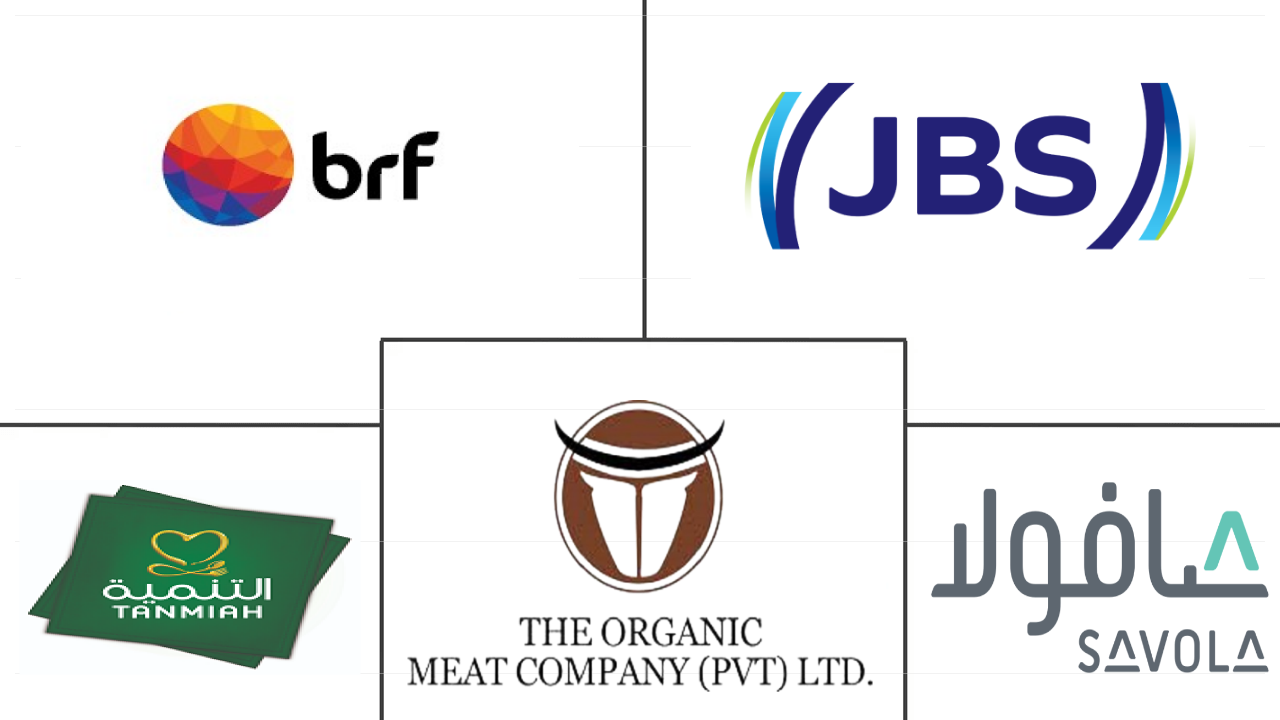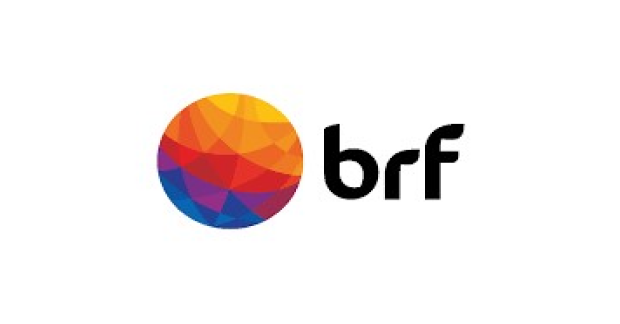Market Size of gcc red meat Industry
|
|
Study Period | 2017 - 2029 |
|
|
Market Size (2024) | USD 3.93 Billion |
|
|
Market Size (2029) | USD 4.31 Billion |
|
|
Largest Share by Type | Mutton |
|
|
CAGR (2024 - 2029) | 1.89 % |
|
|
Largest Share by Country | Saudi Arabia |
Major Players |
||

|
||
|
*Disclaimer: Major Players sorted in no particular order |
GCC Red Meat Market Analysis
The GCC Red Meat Market size is estimated at 3.93 billion USD in 2024, and is expected to reach 4.31 billion USD by 2029, growing at a CAGR of 1.89% during the forecast period (2024-2029).
3.93 Billion
Market Size in 2024 (USD)
4.31 Billion
Market Size in 2029 (USD)
4.13 %
CAGR (2017-2023)
1.89 %
CAGR (2024-2029)
Largest Segment by Type
52.50 %
value share, Mutton, 2023
Mutton in the form of fresh and chilled have a higher penetration in the market for these are easily available and considered better in quality, mainly grass-fed ones.
Largest Segment by Country
33.76 %
value share, Saudi Arabia, 2023
Beef is the largest consumed red meat in Saudi Arabia. The local regulatory bodies are encouraging local producers to boost meat production to cater to the surging demand.
Fastest-growing Segment by Type
1.91 %
Projected CAGR, Mutton, 2024-2029
The rise of expat population and tourism in the region is driving the demand for mutton meat. Fresh and chilled mutton is likely to be the fastest-growing form in the region.
Fastest-growing Segment by Country
2.28 %
Projected CAGR, Saudi Arabia, 2024-2029
The influx of expats into Saudi has resulted in the globalization of cuisine preferences and a rise in the public appetite for meat products, including pork products.
Leading Market Player
3.73 %
market share, BRF S.A., 2022

In the GCC region, BRF. SA and its sub-brands have high brand equity. Around 90% of the population has brand recognition in the Islamic market for its halal products.
A diverse range of gastronomic preferences drives the demand for various meat products
- Mutton is the major red meat type consumed, and consumption is largely dominated by mutton due to the religious affiliations of Bahrain's population. The current population of Bahrain in 2023 is 1,485,509, a 0.9% increase from 2022. Bahrain, Qatar, and Kuwait have the highest per capita consumption of mutton in the region. The rise in mutton consumption in Bahrain can be attributed to increased disposable incomes. Bahrain's Gross National Disposable Income per capita was at USD 22,707.50 in 2022. The country has also seen an increase in the ex-pat population from Western and Asian nations over the past two decades, leading to a more diverse range of gastronomic preferences, including items like hamburgers.
- Apart from mutton and other meat, pork is expected to be the fastest-growing meat consumed in the region, with an anticipated CAGR of 10.50% during the forecast period (2023-2029). The demand for pork increased in the region due to the increased ex-pat population. In 2022, 12.9% of the UAE population was Christian. Similarly, other Middle Eastern countries like Cyprus (which has a 78% Christian population), Lebanon, and Egypt have high Christian populations. This population group consumes all types of red meat, including pork, resulting in higher consumption.
- Beef is the second most consumed meat in the region, and Bahrain has the highest per capita beef consumption, amounting to 15.80 kg in 2023. The country relies on beef imports from New Zealand, Pakistan, and the United Arab Emirates. Most fresh meat cuts available through online channels are New Zealand's Beef Sirloin, Topside Steak, and Silverside Steak. Future growth is expected to be in high-end foodservice, particularly in countries that are looking to develop their tourism industries, such as Saudi Arabia.
Initiatives on self-sufficiency are anticipated to boost the market
- Red meat consumption in GCC countries observed a growth rate of 20.61% by value from 2017 to 2022. The expenditure on imported meat tends to be higher in the Middle East, particularly in the Gulf Cooperation Council (GCC) countries with a growing and affluent population. Quality, Halal assurance, and taste are the major factors considered by consumers in the Middle Eastern region when making red meat buying decisions. However, sustainability is not the main reason consumers buy beef and lamb.
- Saudi Arabia held the major share and highest CAGR by value in 2022. The red meat market in Saudi Arabia grew by 17.36% in value from 2017 to 2022. The increased consumption is a result of growing demand attributed to the rising disposable income and the increasing local production. Saudi Arabia has very high Halal standards set by the Saudi Food and Drug Authority (SFDA), which helps boost consumer confidence in Saudi products. Processed red meat is the fastest-growing segment in the country owing to busy lifestyles, the increasing number of working women, and other factors.
- Oman is anticipated to be the second fastest-growing red meat-consuming country during the forecast period (2023-2029). It is anticipated to register a growth of 2.23% by value. Increasing investments from the government to support self-sufficiency has played an important part in the growth. State-backed enterprises, including red meat-producing companies, continue to enhance production and are offered investment opportunities. Among red meat, consumption in Oman is largely dominated by mutton, mainly due to the religious affiliation of Omani consumers. Mutton is often used in traditional dishes such as shawarma, kebabs, and biryani.
GCC Red Meat Industry Segmentation GCC Red Meat Industry Segmentation
Beef, Mutton are covered as segments by Type. Canned, Fresh / Chilled, Frozen, Processed are covered as segments by Form. Off-Trade, On-Trade are covered as segments by Distribution Channel. Bahrain, Kuwait, Oman, Qatar, Saudi Arabia, United Arab Emirates are covered as segments by Country.
- Mutton is the major red meat type consumed, and consumption is largely dominated by mutton due to the religious affiliations of Bahrain's population. The current population of Bahrain in 2023 is 1,485,509, a 0.9% increase from 2022. Bahrain, Qatar, and Kuwait have the highest per capita consumption of mutton in the region. The rise in mutton consumption in Bahrain can be attributed to increased disposable incomes. Bahrain's Gross National Disposable Income per capita was at USD 22,707.50 in 2022. The country has also seen an increase in the ex-pat population from Western and Asian nations over the past two decades, leading to a more diverse range of gastronomic preferences, including items like hamburgers.
- Apart from mutton and other meat, pork is expected to be the fastest-growing meat consumed in the region, with an anticipated CAGR of 10.50% during the forecast period (2023-2029). The demand for pork increased in the region due to the increased ex-pat population. In 2022, 12.9% of the UAE population was Christian. Similarly, other Middle Eastern countries like Cyprus (which has a 78% Christian population), Lebanon, and Egypt have high Christian populations. This population group consumes all types of red meat, including pork, resulting in higher consumption.
- Beef is the second most consumed meat in the region, and Bahrain has the highest per capita beef consumption, amounting to 15.80 kg in 2023. The country relies on beef imports from New Zealand, Pakistan, and the United Arab Emirates. Most fresh meat cuts available through online channels are New Zealand's Beef Sirloin, Topside Steak, and Silverside Steak. Future growth is expected to be in high-end foodservice, particularly in countries that are looking to develop their tourism industries, such as Saudi Arabia.
| Type | |
| Beef | |
| Mutton | |
| Other Meat |
| Form | |
| Canned | |
| Fresh / Chilled | |
| Frozen | |
| Processed |
| Distribution Channel | ||||||
| ||||||
| On-Trade |
| Country | |
| Bahrain | |
| Kuwait | |
| Oman | |
| Qatar | |
| Saudi Arabia | |
| United Arab Emirates |
GCC Red Meat Market Size Summary
The GCC red meat market is experiencing a steady growth trajectory, driven by increasing disposable incomes and a diverse expatriate population. Mutton remains the dominant type of red meat consumed, particularly in Bahrain, Qatar, and Kuwait, where per capita consumption is notably high. The rise in mutton consumption is largely attributed to the religious affiliations of the local populations and the influx of expatriates from Western and Asian countries, which has also introduced a broader range of culinary preferences. While mutton leads in consumption, pork is emerging as the fastest-growing meat segment, fueled by the increasing number of expatriates, particularly Christians, in the region. Beef holds the position of the second most consumed meat, with Bahrain leading in per capita beef consumption, relying heavily on imports from countries like New Zealand, Pakistan, and the UAE.
The market landscape is characterized by a fragmented structure with major players such as BRF S.A., JBS SA, Tanmiah Food Company, The Organic Meat Company Ltd, and The Savola Group holding a modest share. Saudi Arabia commands a significant portion of the market, benefiting from high Halal standards and a growing demand for processed red meat, which caters to the busy lifestyles of its residents. Oman is poised to be the second fastest-growing market, supported by government investments aimed at achieving self-sufficiency in red meat production. The region's reliance on imported beef, coupled with restrictions and disease outbreaks, has prompted efforts to boost local production, particularly in Kuwait. The GCC's affluent population continues to drive high spending on premium meats, with Western-style food services expanding rapidly, further increasing the demand for high-quality beef grades and cuts.
GCC Red Meat Market Size - Table of Contents
-
1. MARKET SEGMENTATION (includes market size in Value in USD, Forecasts up to 2029 and analysis of growth prospects)
-
1.1 Type
-
1.1.1 Beef
-
1.1.2 Mutton
-
1.1.3 Other Meat
-
-
1.2 Form
-
1.2.1 Canned
-
1.2.2 Fresh / Chilled
-
1.2.3 Frozen
-
1.2.4 Processed
-
-
1.3 Distribution Channel
-
1.3.1 Off-Trade
-
1.3.1.1 Convenience Stores
-
1.3.1.2 Online Channel
-
1.3.1.3 Supermarkets and Hypermarkets
-
1.3.1.4 Others
-
-
1.3.2 On-Trade
-
-
1.4 Country
-
1.4.1 Bahrain
-
1.4.2 Kuwait
-
1.4.3 Oman
-
1.4.4 Qatar
-
1.4.5 Saudi Arabia
-
1.4.6 United Arab Emirates
-
-
GCC Red Meat Market Size FAQs
How big is the GCC Red Meat Market?
The GCC Red Meat Market size is expected to reach USD 3.93 billion in 2024 and grow at a CAGR of 1.89% to reach USD 4.31 billion by 2029.
What is the current GCC Red Meat Market size?
In 2024, the GCC Red Meat Market size is expected to reach USD 3.93 billion.

